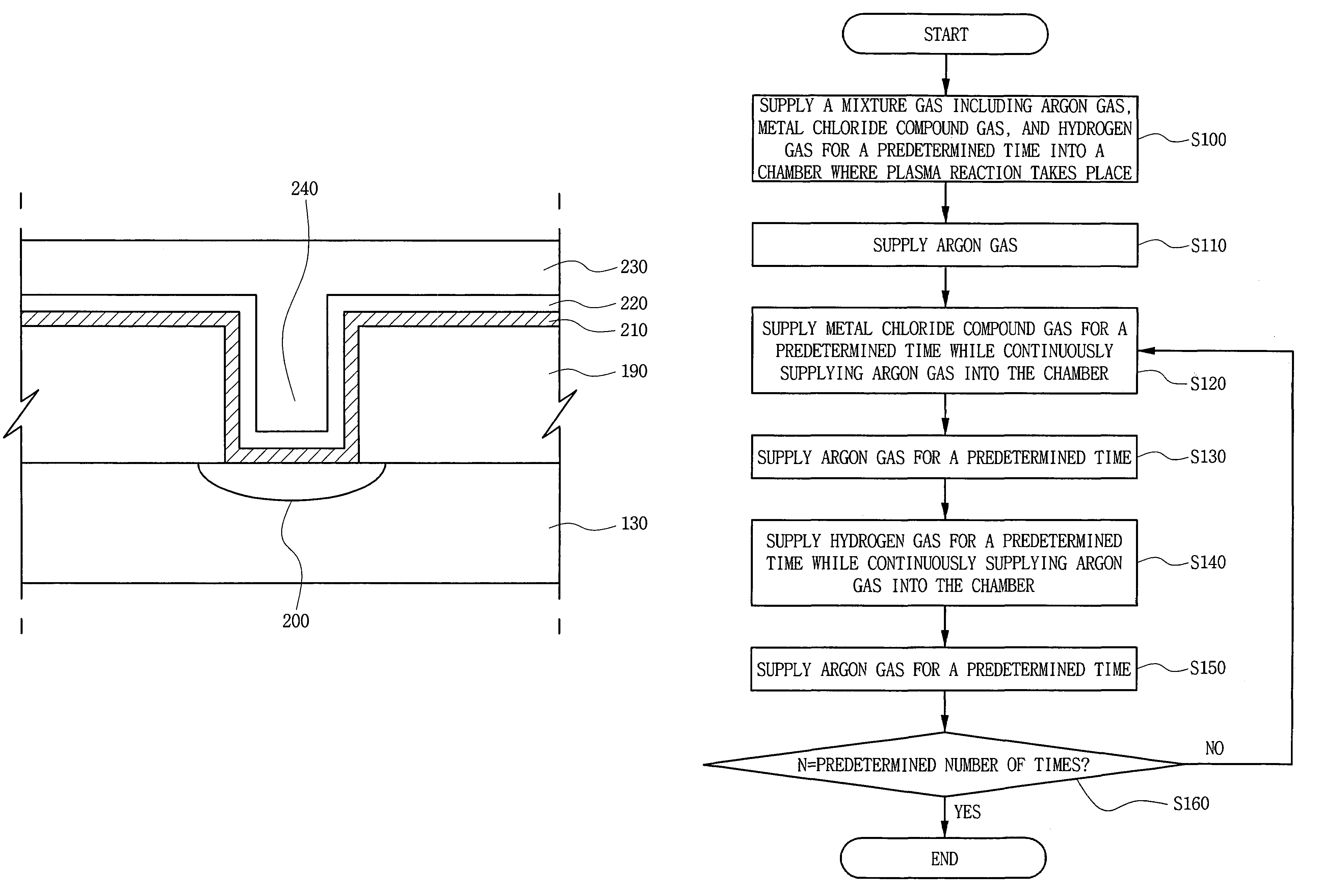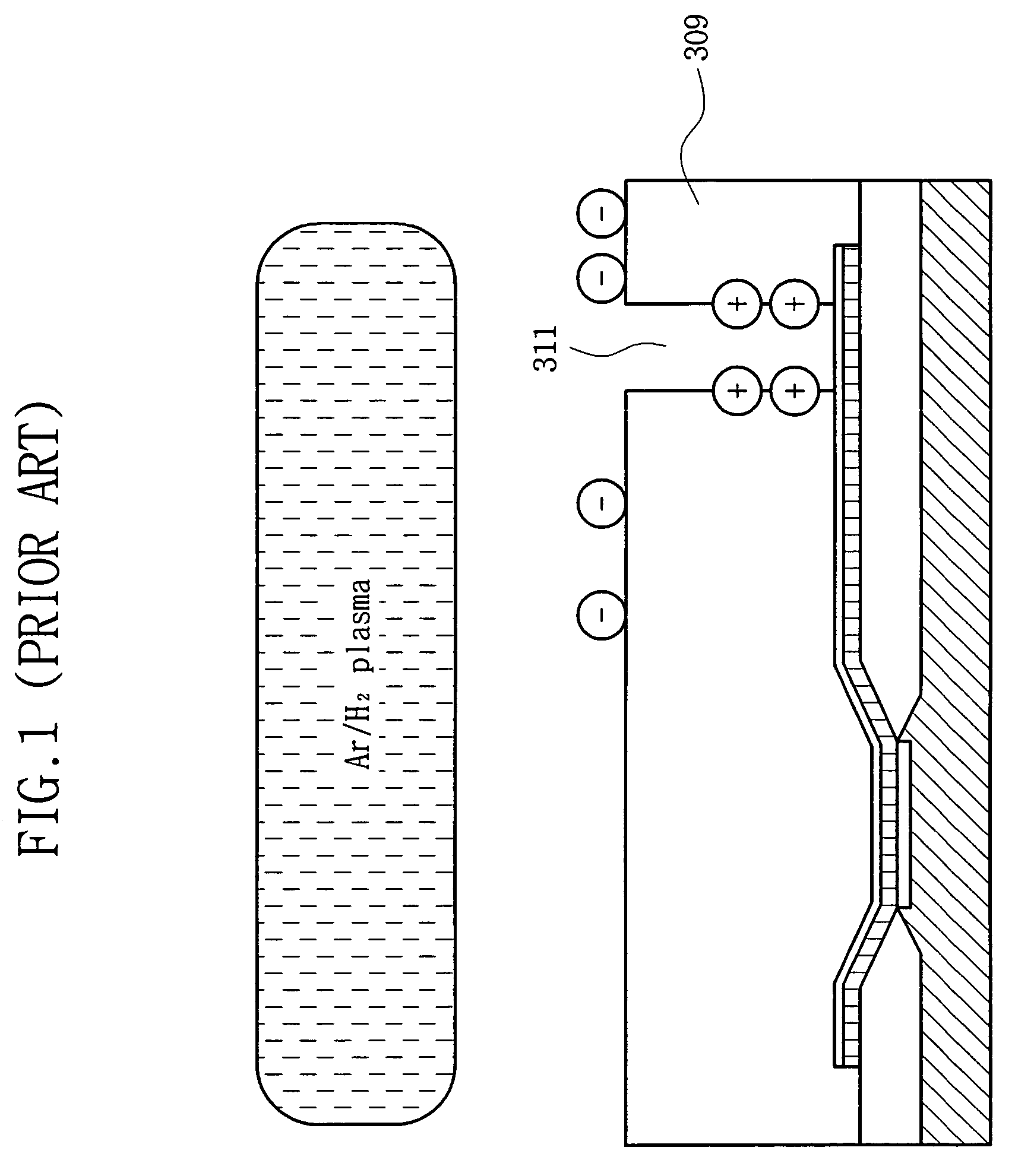Method of forming metal layer used in the fabrication of semiconductor device
a metal layer and semiconductor technology, applied in the direction of coatings, metallic material coating processes, chemical vapor deposition coatings, etc., can solve the problems of poor step coverage, forth new problems, worse coverage, etc., and achieve the effects of increasing the supplying time of hydrogen gas, increasing the plasma reaction energy, and increasing the plasma reaction energy
- Summary
- Abstract
- Description
- Claims
- Application Information
AI Technical Summary
Benefits of technology
Problems solved by technology
Method used
Image
Examples
first embodiment
[0048]FIG. 4 is a flow chart schematically illustrating a method of forming the titanium layer 210 according to the present invention.
[0049]As shown in FIG. 4, a mixture gas including hydrogen and metal chloride compound (TiCl4) and a purge gas are supplied concurrently for a predetermined time into the sealed chamber 100 (FIG. 2), thereby forming a first titanium layer on the exposed conductive layer of a semiconductor substrate 130 using a PECVD method (S100).
[0050]Here, the first titanium layer is composed of titanium silicide at the interface of the conductive region 200 or the contact pad, and is formed with a predetermined thickness at a temperature necessary to form metal silicide.
[0051]For example, the first titanium layer may be formed with a thickness of about 30 Å by flowing an argon gas at about 300 sccm, a hydrogen gas at about 2000 sccm, and a metal chloride compound gas at about 3 to 5 sccm inside the chamber 100 for about 5 to 6 seconds. At this time, a pressure of t...
second embodiment
[0061]FIG. 7 is a flow chart schematically illustrating a method of forming a titanium layer according to the present invention.
[0062]Referring to FIG. 7, the method of forming a titanium layer 210 according to a second embodiment of the present invention includes flowing only an argon gas at a predetermined flow rate for a predetermined time (S200).
[0063]Then, while the argon gas is continuously flowed into the chamber 100, a metal chloride compound gas is supplied for a predetermined time (S210). Then, the supplying of the metal chloride compound gas is stopped, and only the argon gas is flowed into the chamber 100 for a predetermined time (S220). Then, while the argon gas is continuously flowed, the hydrogen gas is supplied for a predetermined time (S230), thereby forming the titanium layer 210.
[0064]Then, the supplying of the hydrogen gas is stopped, and only the argon gas is flowed into the chamber 100 for a predetermined time. The metal chloride compound gas and the hydrogen g...
third embodiment
[0070]FIG. 9 is a flow chart schematically illustrating a method of forming a titanium layer according to the present invention.
[0071]Referring to FIG. 9, in the method of forming the titanium layer 210 according to a third embodiment of the present invention, only the argon gas is flowed at a predetermined flow rate inside the chamber 100 for a predetermined time with a predetermined RF power (S300). For example, about 200 W of RF power is applied to the upper electrode 170 to induce plasma reaction inside the chamber 100.
[0072]Then, while the argon gas is continuously flowed into the chamber 100, the metal chloride compound gas is supplied for a predetermined time (S310). Then, the supplying of the metal chloride compound gas is stopped, and only the argon gas is flowed into the chamber 100 for a predetermined time (S320). In the same way, about 200 W of RF power is applied to the upper electrode 170 to induce plasma reaction inside the chamber 100. Then, the argon gas is continuo...
PUM
| Property | Measurement | Unit |
|---|---|---|
| purge time | aaaaa | aaaaa |
| temperature | aaaaa | aaaaa |
| frequency | aaaaa | aaaaa |
Abstract
Description
Claims
Application Information
 Login to View More
Login to View More - R&D
- Intellectual Property
- Life Sciences
- Materials
- Tech Scout
- Unparalleled Data Quality
- Higher Quality Content
- 60% Fewer Hallucinations
Browse by: Latest US Patents, China's latest patents, Technical Efficacy Thesaurus, Application Domain, Technology Topic, Popular Technical Reports.
© 2025 PatSnap. All rights reserved.Legal|Privacy policy|Modern Slavery Act Transparency Statement|Sitemap|About US| Contact US: help@patsnap.com



